Monarch Hornet Pro: "SFF" meets PCI Express, DDR2
by Evan Lieb on July 31, 2004 12:05 AM EST- Posted in
- Systems
Monarch Hornet Pro: Chassis (continued)
Unlike a lot of SFF manufacturers, Monarch outfits the Hornet Pro with a standard HSF (Heatsink and Fan). This is in contrast to heatpipe solutions from most other SFF manufacturers, or some variation of that cooling technology. However, using the stock HSF actually isn't too unusual for an LGA775 SFF system, at least the handful that we've encountered. Remember, the force being applied to a Socket 775 Prescott CPU isn't coming from the HSF nearly as much as it used to with Socket 478 Prescotts. The force being applied onto the CPU is coming mostly from the retention clip mechanism on the new LGA775 socket itself. That clip, in combination with a stock HSF cooler, is enough to properly dissipate the heat produced by the CPU. It's mind boggling how hot these 0.09-micron Prescotts could have been without a new socket infrastructure, as we were told the "old" way of dissipating heat isn't nearly as good as the retention clip way of dissipating heat. Thankfully, due to the D925XBC motherboard's BIOS fan speed control options, it was also very easy to get the processor fan to spin at a very low noise level.
One of the very first concerns that we had with the introduction of such a high-end SFF was whether or not Monarch would use a powerful enough PSU (power supply unit). For example, thermal throttling is not at all that uncommon with today's Prescott platforms if you don't use the properly rated 24-pin PSU. Indeed, we've experienced throttling (in case you didn't know, throttling can drastically reduce system performance to a crawl) with 20-pin PSUs. We highly suggest using a 24-pin PSU from a quality manufacturer if you're at all interested in a high end system filled to the brim, a system similar to Monarch's most expensive Hornet Pro configuration. Anyway, with that all said, we were pleased to hear that Monarch provided a Topower TOP350FX 350W PSU. This is a very good PSU that'll provide a consistent stream of stable voltages to your components without fail. We experienced no throttling with this system whatsoever after several days of testing. That alone isn't necessarily enough to calm any fears, though, since voltage instability can sometimes creep up on you weeks or even months down the road without the proper care and right ventilation. Still, we're confident in Monarch's choice of PSU and our experience during testing gives us nothing to worry about so far.
Like most good SFFs these days, the Monarch Hornet Pro left enough room for high end video cards such as the Radeon 9800 Pro and GeForce FX 5900 Ultra. We were, therefore, able to fit a standard 128MB 9800 Pro inside the Hornet Pro quite easily (in theory of course, since there are no PCI-e 9800 Pro cards yet). Even though both ATI and NVIDIA's high end cards are still primarily 9800 Pro cards or 5900 Ultra cards, their next generation cards are just now starting to reach retail in quantity. ATI's X800 and their various iterations have been on the market for about a couple months now, and are really starting to hit the mainstream in quantity with the X600 revision. Just as with the 9800 Pro, the X800 was easy to install and didn't really take up any space that could interfere with other components in the Hornet Pro. In fact, we have never seen so much space around a video card inside an SFF. Of course, since ATI and NVIDIA's flagship cards are the largest and bulkiest of them all, any stripped down version of either company's flagship should fit inside the Hornet Pro without any trouble whatsoever. For example, we were easily able to fit in ATI X600 cards (XT revisions) and NVIDIA 6800GT cards (again, in theory, since GT cards haven't gone PCI-e yet) inside the Hornet Pro.
We very much enjoyed seeing a good number of I/O ports included in the rear of the Hornet Pro's Intel D925XBC mATX motherboard. In total, there are four USB 2.0 ports, one 10/100/1000 GbE LAN port, one IEEE1394 FireWire port, five audio ports (Mic in, Line in, Line out, SPDIF out/in), two PS/2 ports, and a serial and parallel port. As always, we are pleased to see rear IEEE 1394 FireWire, as it's never fun to deal with installing and routing a FireWire bracket in any SFF, no matter how much space there is available. FireWire will be quite necessary if you demand high throughput for large files, especially if you're a digital camera user. Every other port is fairly standard for a high-end system and is more than self-explanatory.
The Hornet Pro's accessory kit is quite nice. It includes an Intel Desktop Board Quick Reference booklet, driver CDs with DVD playing and burning software, RAID driver floppy, Windows XP Professional SP1a OEM pack, VGA to DVI converter, 4-pin female/male connector, 3-pin PSU cable, two drive bay face plates, one expansion slot cover, one additional carrying handle (top), a T-shirt, and finally, the Monarch Hornet Pro User Setup Guide (manual). The Hornet Pro manual was a pleasant surprise; the literature provided was all up to date and accurate from what we could tell, and the installation procedures were straight forward and simple enough that even novice users would understand. While I still don't think you can get any better than a Shuttle SFF manual, the Monarch Hornet Pro manual was good enough that it was worthy of mention.
One final accessory that we did not receive with our review system, but that will be shipping with Hornet Pro systems this month, is a can of paint. The paint is an especially nice touch for the Mustang yellow and Ferrari red versions of the Hornet Pro, since you can quite easily chip them if you're someone that likes to swap and tweak hardware parts (screw drivers) for fun. Because each color is light, a bad enough chip could stand out quite a bit.


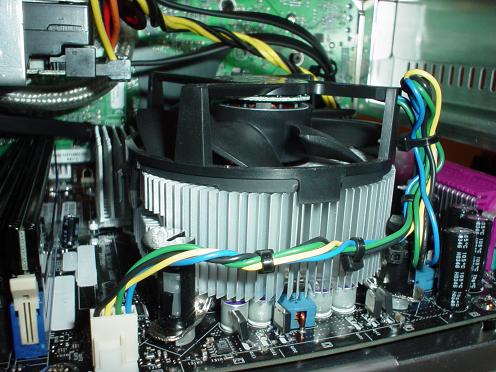
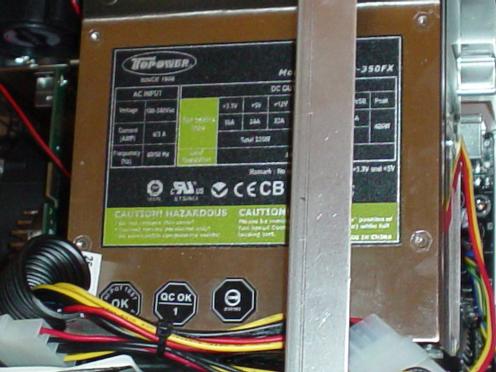
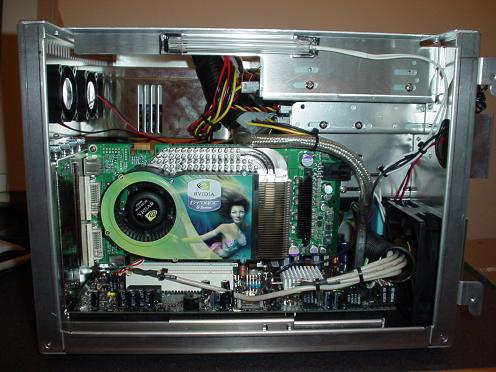
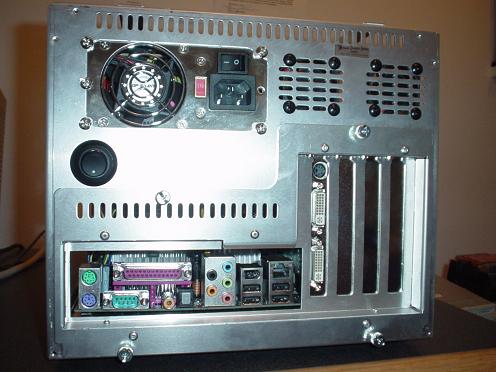
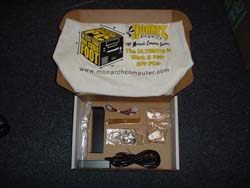
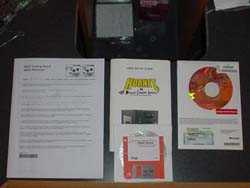








7 Comments
View All Comments
MichelMerlin - Monday, August 2, 2004 - link
What I like in this SFF is its size and according ability to receive more changes than the Shuttle models, for instance big silent GC cooling systems.However the article (excellent otherwise) should tell IMO if the system, as delivered, is silent enough during regular activities (excluding leading edge games but including some ordinary games)
Paris, Mon 2 Aug 2004 09:28:35 +0200
Bonesdad - Saturday, July 31, 2004 - link
Who is the little guy inside the case? Does he make the wheels go round?bupkus - Saturday, July 31, 2004 - link
I like the hybrid approach between the traditional microATX and SFF as it should allow mainboard options unavailable with the SFF.Unfortunately, they only allow the microATX PS which usually comes with a much lower wattage.
Just a broader comment here:
With so much being put on the mainboard I would think fewer people really need all those PCI slots. I for one don't see my ever needing an ATX mainboard when the microATX boards provide all the slots I will need. Smart move by Monarch. I'll be looking for when the prices come down.
Spacecomber - Saturday, July 31, 2004 - link
Oops, I guess you can't edit these notes. I meant to say 10,000 rpm "drives" not fans.While I'm at it, did you notice that this chassis has a removable motherboard tray?
skunkbuster - Saturday, July 31, 2004 - link
to me it just looks kind of generic. i wish they spent some time 'revamping' the exterrior..can't really compare to a shuttle in that aspect..
Spacecomber - Saturday, July 31, 2004 - link
Looks like this motherboard requires a custom I/O shield, which Intel didn't supply?Yeah, I know, I'm being pretty picky.
Thanks for bring these barebones to my attention.
By the way, how did the system hold up with temperatures after running some programs that would heat up the processor, video card, and hard drives? Some idle vs load temp comparisons would have been interesting. If I followed the case description properly, there are two 40mm fans in the back and an 80 mm intake fan in the front (and the P/S, of course) for cooling this system. Do the dual 10,000 rpm fans have enough room to breath? I couldn't quite picture where they are in the case from the photos.
Space
Zepper - Saturday, July 31, 2004 - link
Monarch is a sharp company - just wanted to be the first to post a comment.. Well written article! this type of system is not my cup of tea but monarch has plenty of others to ease that plastic out of your wallet...
.bh.